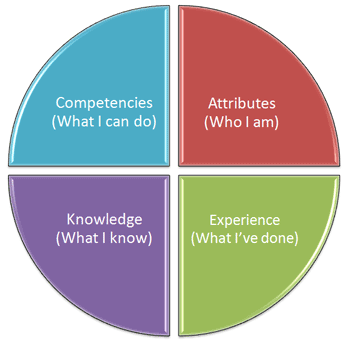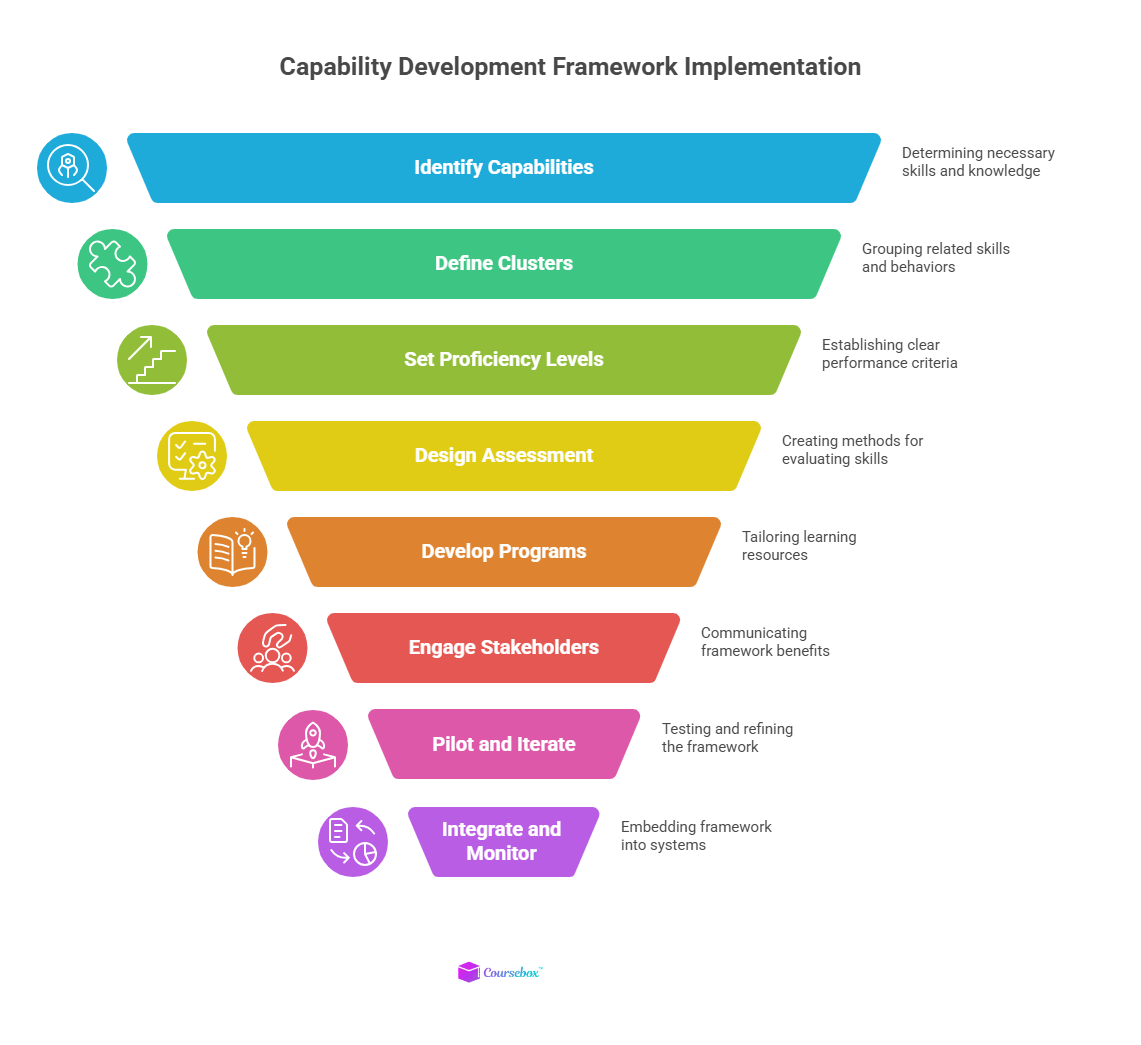Leveraging Capability Development Framework to Build a Skilled Workforce
Want to build an agile workforce by upskilling your employees? Here is how you can leverage the capability development framework to develop effective training.
Want to build an agile workforce by upskilling your employees? Here is how you can leverage the capability development framework to develop effective training.

Building a skilled workforce is one of the biggest challenges many businesses face today. In one World Economic Forum research, businesses predicted that technological advancements like AI will disrupt 44% of workers’ core skills by 2027. This makes upskilling your workforce more important than ever.
For many organizations, providing effective training is still easier said than done. You have to provide training that truly moves the needle while meeting rapidly changing industry demands. Yet, traditional training programs often fall short and lack clear links to business goals.
This is where a capability development framework (CDF) becomes a game-changer. Think of it as a strategic blueprint that clearly defines what skills, knowledge, behaviors, and tools are needed for each role in your company. With a well-structured CDF, you empower your teams with a clear development roadmap linked directly to what your business needs to succeed.
In this post, we will discuss what a CDF is and how you can build and leverage one effectively.

A capability development framework is a structured model that outlines the mix of skills, knowledge, behaviors, tools, and processes your employees need to perform their roles effectively and help your organization meet its goals. Think of it as a roadmap for workforce development, linking what individuals do day to day to the bigger picture of business success.
Traditional skills lists or job descriptions just name tasks. Comparatively, a CDF focuses on capabilities as outcomes. It defines what employees should be able to do, how they behave, and what expertise they bring to the table at different proficiency levels.
For example, a customer service role in your company might include capabilities like effective communication, empathy, and problem-solving, each described at beginner, intermediate, and expert levels. This clarity makes expectations transparent and development more targeted.
A robust CDF not only guides recruitment and role clarity but also fuels learning and performance management. It helps you identify skill gaps, tailor training programs, and track progress in a consistent, strategic way. When used properly, a CDF can help you build a skilled, agile workforce aligned with your organizational strategy.

Building and implementing a capability development framework (CDF) might seem like a big task, but breaking it down step by step makes it manageable. Here’s how you can implement your CDF successfully:
Start by understanding your organization’s business strategy and future direction.
What are the key objectives your company wants to achieve in the next 1-3 years? For example, if your goal is global expansion, you might need capabilities, such as international sales expertise or cross-cultural communication skills.
Engage leadership and key stakeholders in brainstorming sessions or workshops to validate which capabilities are mission-critical versus nice-to-have. This ensures your CDF is aligned with your business priorities.
Break down the required capabilities into clusters or groups of related skills, knowledge, and behaviors. Each cluster should cover a specific performance dimension.
For example, a cluster for “Customer Service” might include empathy, product knowledge, and conflict resolution. Define expected behaviors for each capability at different proficiency levels.
This detailed breakdown enables employees to understand what’s expected and managers to assess performance accurately.
The next step is to develop clear, observable criteria that describe what it means to perform at different proficiency levels. For instance, a beginner might handle routine customer queries, whereas an expert could resolve complex issues independently and mentor others.

This makes progress measurable and transparent, giving employees clear targets to aim for and a pathway to grow within their roles.
Now, decide how you will assess capabilities and gather feedback. Use a combination of self-assessment, peer reviews, and manager evaluations. You can also leverage objective measures, such as certifications or performance data.
For example, after completing a training module on conflict resolution, employees might role-play scenarios to demonstrate their skills and receive feedback from supervisors.
Create or curate learning resources tailored to the capabilities and proficiency levels you’ve outlined. This might include online courses, workshops, mentorship programs, and on-the-job assignments.
Mixing various learning modalities ensures you cater to different learning styles and schedules. You can also use AI-powered platforms to generate personalized, competency-aligned training courses at scale.

Make sure all stakeholders, including leaders, managers, HR teams, and employees, understand the purpose and benefits of the capability development framework. Communicate how it will be used in recruitment, development, performance management, and career planning. Regular updates and feedback help build trust and buy-in, making adoption smoother.
Start by piloting your framework with a specific department or team. Gather feedback on usability, relevance, and outcomes, then refine the framework accordingly. This iterative process ensures the framework fits your organization’s unique culture and needs.
Once tested, plan a phased rollout to other parts of the company.
Embed your CDF into existing talent management systems like Learning Management Systems (LMS), performance review platforms, or HR Information Systems. Use analytics and reports to track capability development, identify skill gaps, and adjust learning interventions dynamically.
For example, when a learner completes a course, the system can automatically update their proficiency level and trigger new learning recommendations.
You have built and implemented a CDF for your workforce, but how do you know whether it is working? For that, you need to set and measure success metrics.
Start by defining key performance indicators (KPIs) aligned with your business goals. These can include improvements in skill proficiency measured through assessments, employee engagement scores during training, and learning completion rates. For example, track how many employees advance their skills from beginner to intermediate within certain timeframes.
Performance metrics are also critical. Monitor how capability growth translates into actual job performance, such as increased sales or higher customer satisfaction scores. Career progression stats, such as internal promotions, retention rates, and employee satisfaction surveys, provide insight into how well your framework supports talent growth and engagement.
Use data analytics tools to gather these insights in real time. Dashboards can highlight skill gaps and the impact of training, enabling you to make data-driven adjustments to learning programs.
Finally, embrace continuous improvement as a mindset. Regularly collect feedback and update your framework and training content based on evolving business needs and learner experiences. With ongoing measurement and refinement, your capability development stays relevant and impactful, fueling long-term organizational success.
Technology plays a crucial role in building and sustaining a skilled workforce. AI-powered tools like Coursebox can be your strategic partner in this regard.
Coursebox leverages advanced AI technology to streamline and enhance every stage of your capability development framework implementation. Its course creator instantly converts existing documents, videos, or websites into fully interactive courses aligned with your competency standards.
Coursebox also offers dynamic quiz generation and automated grading that instantly assesses learner progress. This real-time feedback loop helps learners understand their strengths and areas for improvement immediately, much like having a personal tutor. The platform includes AI chatbots trained on the course content, providing learners with 24/7 conversational support.

Beyond course creation and assessment, Coursebox integrates seamlessly with existing LMS and HR tools via APIs and standards such as SCORM and LTI. This means you can embed your CDF-driven learning programs into your current workflows without disruption.
Coursebox makes it practical and efficient to implement and scale your capability development framework. Sign up for free now to get started!
A CDF is a structured model that defines the skills, knowledge, behaviors, and tools employees need to succeed in their roles and support business goals. Unlike simple skills lists, it focuses on outcomes and proficiency levels to guide development. This clarity helps align training, performance, and career growth.
Using a CDF aligns workforce development with your strategic priorities, making training targeted and effective. It also improves performance management by providing a common language for assessing skills and growth. Companies find that it boosts employee engagement, retention, and internal mobility.
It starts with identifying critical business goals, then mapping the capabilities required to achieve them. You define capability clusters and proficiency levels, design assessment processes, and align learning programs accordingly. Stakeholder involvement and iteration ensure it fits your unique organization.
Measure skill improvements through assessments, training completion, and performance metrics linked to business outcomes. Employee progression and engagement indicators also provide insight. Platforms like Coursebox support real-time data tracking and continuous improvement.
Coursebox uses AI to quickly create personalized, competency-aligned courses. It also automates grading and feedback, and provides real-time learner support with chatbots. The platform also integrates with existing HR and LMS systems to effectively scale capability building.
